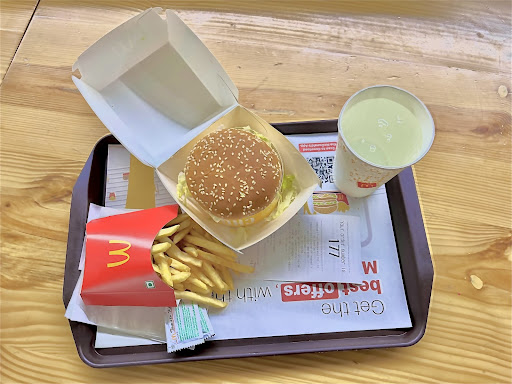Image from Deepthi Sankar.
Fast food has quite the bad reputation. Most people are aware of how addictive and detrimental fast food is to public health, due to its high amounts of cholesterol and simple sugars. These often cause a myriad of health problems: diabetes, heart disease, and obesity, to name a few. Despite these risks, millions of Americans still prefer eating from McDonalds rather than a healthier option. This is especially true at Washington High School, where a large portion of the students prefer to go out and get lunch instead of getting a home cooked meal or a school lunch.
A major reason why fast food is so appealing to students is because it tastes good and is fairly convenient to get. Many students feel that the food provided at school is inferior since it has to be “healthy,” as per the California mandate that requires school food to be “nutritious.” This means fitting the minimum requirements, like no more than 35% total calories from fat, no more than 10% total calories from saturated fat, and no more than 200 calories per individual food item/container, with slight exceptions. To fit the criteria, the school replaces typical ingredients with “healthier” versions, like replacing all purpose flour in their baked goods with whole wheat flour, which would add to the minimum protein requirements. Providing food with more nutritional value isn’t necessarily bad, but the way the food is altered ends up diminishing the quality. An anonymous student comments that the “[school food is] just bland. They put a lot of unhealthy menu items, like burgers and pizza, to make the school food good, like fast food restaurants, but it is blander than actual fast food to make it ‘healthier.’” The student raises the point that instead of providing flavorful, nutritious meals unique to the school, the district ends up providing meals that are simply not as appealing to students. A student from Washington would much rather spend a couple dollars at the local McDonalds to purchase a Big Mac rather than getting a “healthier” version of the same meal at school for free. The same student also comments that fast food is fairly convenient, because they simply don’t have time to prepare a proper meal in the morning. These two factors result in the widespread addiction to fast food, especially at Washington.
Another prominent reason for the overconsumption of fast food is due to the socialization factor. More often than not, groups of students go out to eat during lunch together, since it’s a way for them to spend time with each other and build positive memories. Mrs. Bauer, a health teacher at Washington, comments that “Food that is economical, delicious and easy to access has always been a problem for teachers in a classroom setting. Oftentimes, [their lunch] is the only meal that a student is getting that they truly enjoy.” Mrs. Bauer brings up a valid point that fast food can be a comfort to students, since getting their favorite meal during lunch with their friends can be a great escape from the stress of school. This positive association with fast food only deepens an addiction to it, which is partially the reason why so many students go out of school to get their meals.
With this in mind, it is difficult to think of ideas to combat the addiction to fast food, especially since its roots are connected to issues that are hard to fix, like a lack of free time and stress. However, this does not mean that the problem cannot be solved. Improving the menu by adding different types of food, possibly from different regions, would be a great way to encourage students to eat healthy food from school, since more students would be willing to eat school lunch if it meant sampling cuisine from different cultures. For example, Asian dishes are often prepared with ingredients like tofu, paneer, chickpeas and lentils, which are high in protein but delicious when in a curry or stew. Removing unpopular menu items, and having votes on what kind of food to include would also be a great way to encourage the community to think about what they’re eating. To fix the issue globally, we would need to fix the ingredients and preparation of fast food while still maintaining the taste. But until this happens, we can simply encourage people to cook at home and enjoy the food they make, if they have time. Mrs. Bauer adds that “making good food at home is a great way to motivate yourself to eat better. Processed foods leave you hungry, whereas protein rich foods leave you satiated, which is why people eat so much highly processed foods. By making food at home, you skip all the filler, and it’s very farm to table.”
Overall, fast food is and will continue to be a convenient and delicious way to get your calories for the day. Despite this, a diverse diet with proper nutrition is essential, and by being directly involved in what goes into our diets, we can better ensure our health.
Viswatha Pamidipati is a junior at Washington High School. She was born and raised in Wisconsin, and moved to Fremont when she was 12. She is a first year reporter for The Hatchet who is interested in discussing topics revolving around the local community and social issues, as well as the environment. In her free time, she loves to draw, bake, read, cook, and spend time with her family. She hopes to go into a career in STEM.


